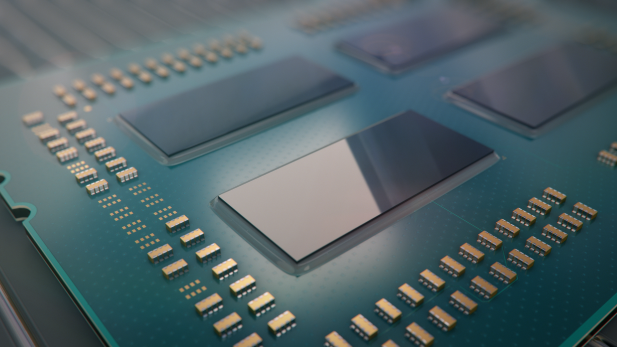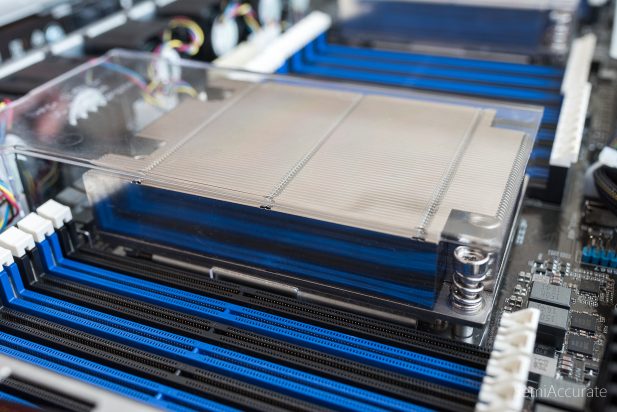Yesterday AMD launched its long awaited re-entry into the x86 server market. In this article we’ll be looking at the different SKUs in this product stack and thinking about how they fit into server market. AMD’s EPYC is available in two single socket and dual socket configurations. The first test chips that AMD sent out to its OEM partners were high-end 180 Watt samples so expect to see the initial wave of motherboards and system designs focus on these high TDP and high core count chips.
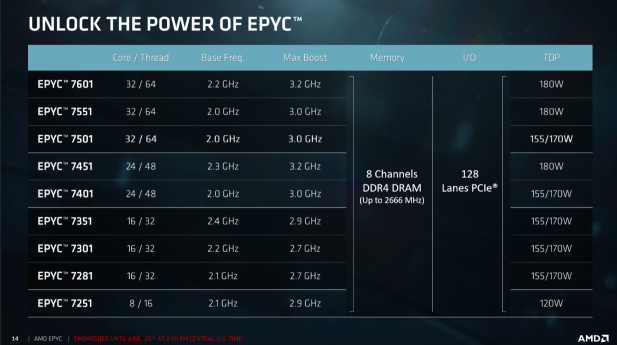
With that in mind lets start at the top with the EPYC 7601 and work our way down to what I think is probably the single most interesting SKU in the stack, the entry-level EPYC 7251. At the launch event today in Austin, Texas AMD and its partners claimed to have set a new world records using the 32 core and 64 thread EPYC 7601 SKU. This SKU has a base clock of 2.2 Ghz and an all core boost clock of 3.2 Ghz paired with a 180 Watt TDP.
Every EPYC SKU offers the same feature set with eight memory channels and 128 PCI-E lanes. The biggest difference between these SKUs is in core count, followed by TDP, and then some largely minor variations in base and boost clock speeds.
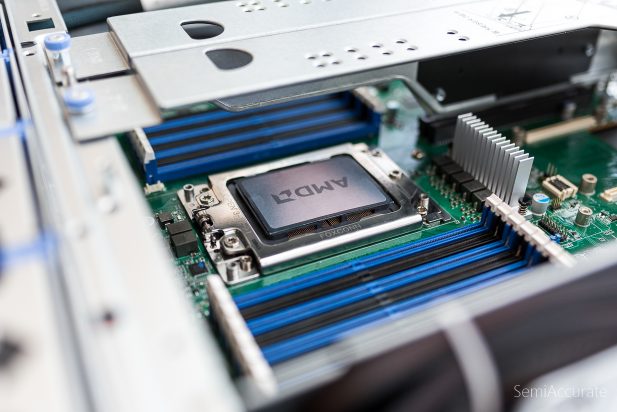
Getting back to AMD’s flagship EPYC chip, the 7601, it set a new world record for a 2 socket system in the SPECint_rate2006 benchmark and two world records, in SPECint_rate2006 and SPECfp_rate2006, for a single socket system. If the 7601 is anything to go by then AMD clearly cares about absolute performance.
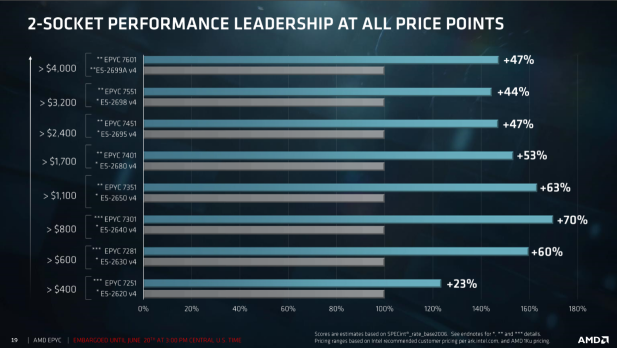
Moving down the stack we have the 7551 and 7501 which offer the same 32 cores as the 7601 but lower clock speeds and in the case of the 7501 a slightly lower TDP. The starting price for one of these 32 core chips is about a quarter’s worth of college tuition at $3400. The next step down are the 24 core parts dubbed the EPYC 741 and 7401 which again differ only slightly in clock speeds and TDPs with the 7401P taking a 10 percent clock speed hit for a 5 percent reduction in TDP. These chips start at $1850.
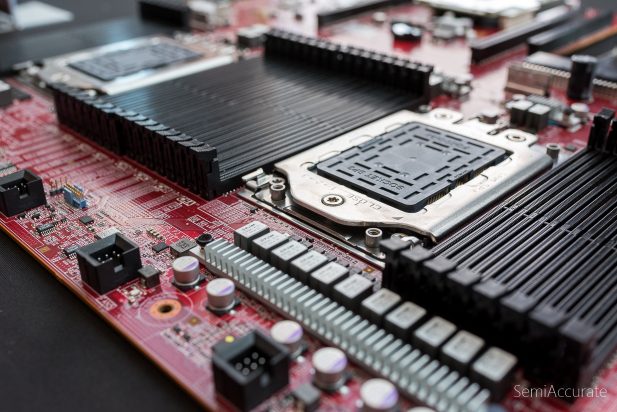
On to the 16 core SKUs which break away from the one fast/slow model of the SKUs above it. The EPYC 7351 sits at the top here with a 170 Watt TDP, 2.4 Ghz base clock, and 2.9 Ghz boost clock. The EPYC 7301 offers 10 percent lower base and boost clock speeds at the same TDP. The last 16 core model is the EPYC 7281 which differs only through a 100 Mhz base clock speed hit compared to its 7301 sibling. Pricing for these 16 core parts starts at a very reasonable $650.
Finally we have what I think is the single most interesting SKU in the whole of the EPYC product stack, the 7251. This is the only 8 core EPYC model that AMD is releasing. It has a base clock of 2.1 Ghz and a boost clock of 2.9 Ghz. Both are low by desktop standards but inline with the clock speeds in the rest of the EPYC line up. It also has a TDP of 120 Watts which seems like a lot but as I covered in my writeup of EPYC’s power management system that number is a shade misleading.
Most importantly this SKU despite having 3/4th of its physical cores disabled still offers all of the memory channels, capacity, and PCI-E lanes of the more expensive EPYC parts. If don’t really much CPU compute, but you do want as many PCI-E lanes as possible then AMD’s low-end EPYC parts are pretty compelling.
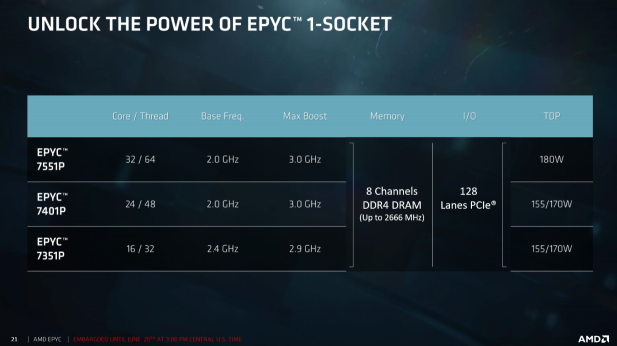
All of these chips are available for use in two socket configurations. Certain models with the P suffix are intended for use in single socket servers like the 7551P, 7401P, and 7351P. Reviewing AMD’s footnotes they’re claiming single socket performance records using a non P suffixed chip the 7601. They’ve also got a slide titled “Disruptive 1-Socket Performance” that has benchmarks for the non SKUs like the 16 core 7281 and the 8 core 7251 parts shown below. This implies that you can use the non-P EPYC chips in a single socket motherboard. You’ll have to forgive us for saying that AMD’s been a tad squishy on what SKUs can be in single socket configurations and exactly how much they cost.
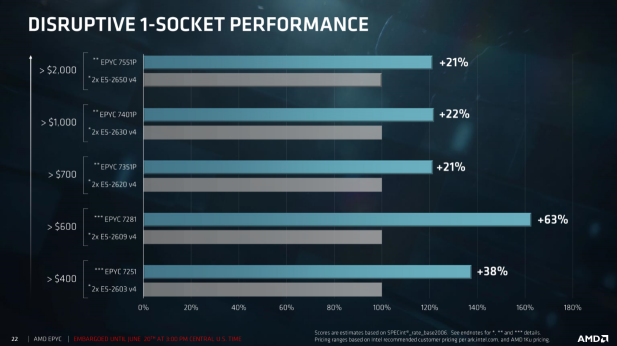
There’s been some controversy about how AMD estimated the performance of not only its own chips but more importantly of Intel’s chips. Obviously when you’re looking at the kind of relative performance advantages that AMD’s touting with EPYC you’d be negligent to not be at least a little suspicious. This is why third-party testing is so valuable. Server vendors need to be held accountable and sun shine is the only way to do so. When looking at these benchmarks I think it’s important not to consider them as gospel, but rather as an indication of AMD’s confidence in EPYC. Until we have reliable third-party comparisons I don’t see much purpose in arguing about EPYC’s performance against competitive Intel parts.S|A
Thomas Ryan
Latest posts by Thomas Ryan (see all)
- Intel’s Core i7-8700K: A Review - Oct 5, 2017
- Raijintek’s Thetis Window: A Case Review - Sep 28, 2017
- Intel’s Core i9-7980XE: A Review - Sep 25, 2017
- AMD’s Ryzen Pro and Ryzen Threadripper 1900X Come to Market - Aug 31, 2017
- Intel’s Core i9-7900X: A Review - Aug 24, 2017
